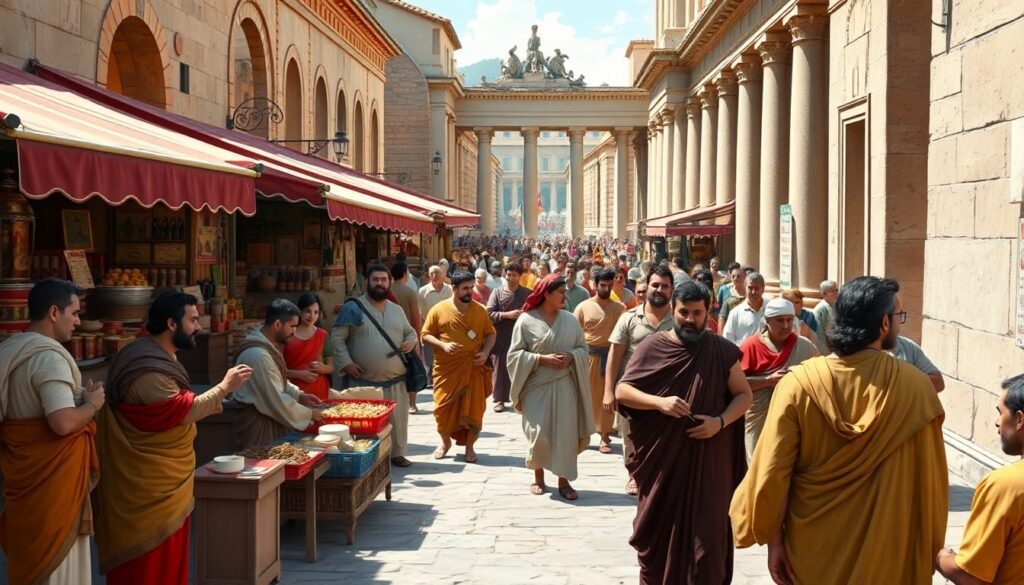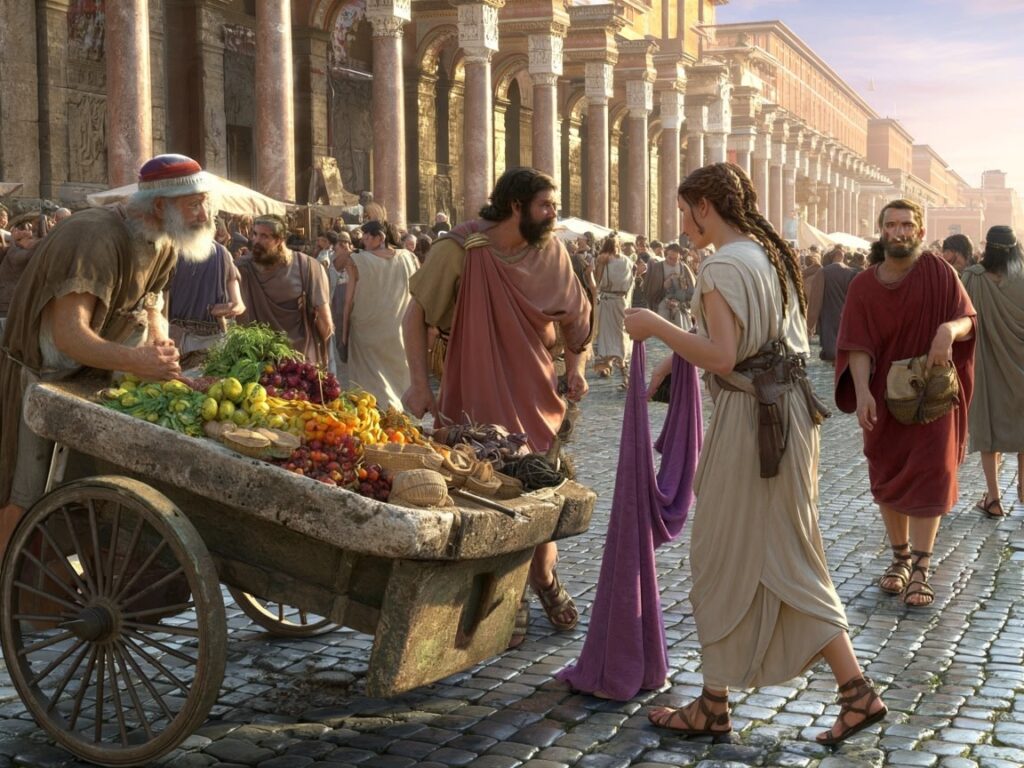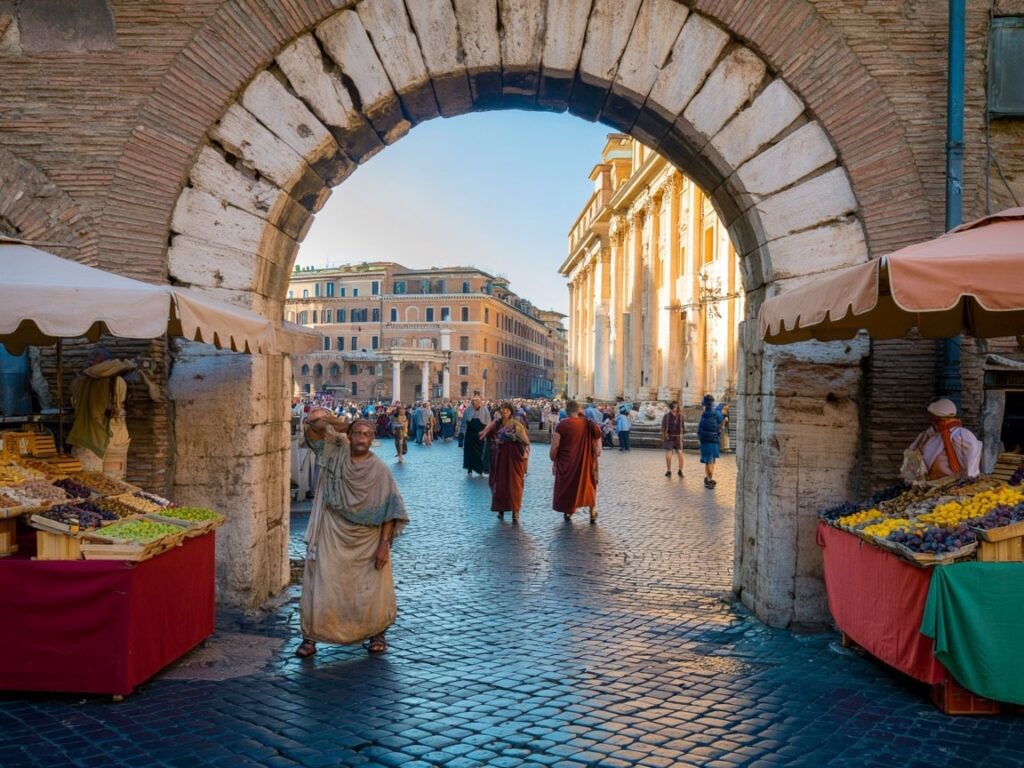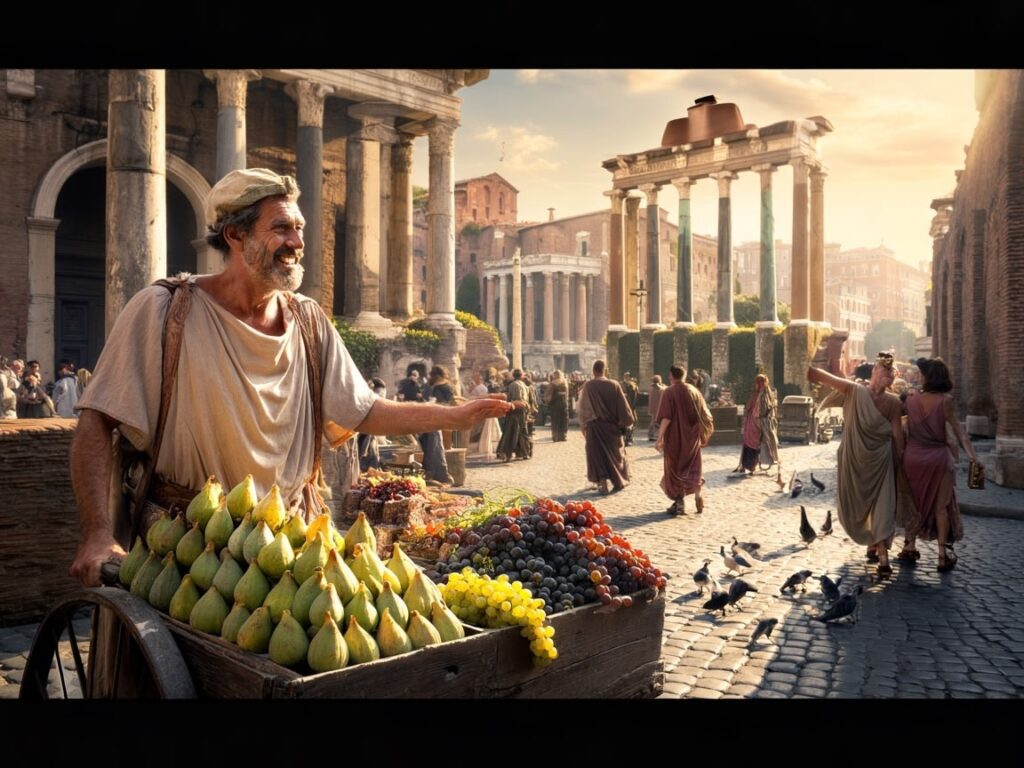Roman Street Life: Vendors, Beggars, and Public Spaces Unveiled offers a vivid glimpse into the bustling urban experience of ancient Rome. The city’s streets were far more than mere pathways; they formed the heartbeat of daily life, pulsing with activity, commerce, and social interaction.
Key players shaped this dynamic environment:
- Vendors, especially food hawkers, provided quick and affordable meals to an urban population that lacked widespread cooking facilities.
- Beggars occupied public spaces visibly, employing diverse tactics to secure aid or sympathy from passersby.
Public spaces in Rome—forums, piazzas, and busy thoroughfares—acted as vibrant centers where people from all walks of life intersected. These areas became stages for economic exchange and social encounters alike. The confluence of vendors selling goods and beggars seeking charity created a complex atmosphere reflecting the city’s social fabric.
Understanding these elements reveals how Roman street life was a microcosm of the broader society—an intricate tapestry woven from commerce, survival strategies, and community interactions within the city’s ever-active public arenas. This exploration is not just limited to street life; it also opens the door to understanding the larger context of the rise and fall of the Roman Empire, which has left an indelible mark on world politics, culture, and society.
Moreover, delving into ancient Rome’s history reveals a tale of innovation, culture, and governance that has significantly influenced modern society. Additionally, one cannot overlook the impact of the Corpus Juris Civilis, a monumental achievement in law that preserved ancient Roman legal principles while adapting them for contemporary use.
The military prowess of the Roman Army also played a crucial role in shaping the empire’s boundaries and maintaining its power. Lastly, the architectural marvels built during this era are a testament to the Romans’ innovative spirit as seen in their masterpieces of ancient engineering.
The Role of Street Vendors in Ancient Rome
In ancient Rome, food hawkers played a vital role in the bustling street life, offering quick and affordable meals to the masses. These vendors were essential in providing nourishment to a densely populated city where many residents lacked adequate cooking facilities. Operating within a complex food distribution network, street vendors ensured a steady supply of goods to meet the demands of the urban population.
The Informal Economy of Ancient Rome
The informal economy in ancient Rome was diverse, with street vending being just one aspect of a larger unregulated system that encompassed various forms of trade. Besides food hawkers, the informal economy included:
- Barbers
- Teachers
- Fortune tellers
- Prostitutes
- Casual labor seekers
This network of informal workers contributed significantly to the daily life and commerce of the city.
The Social Impact of Street Vendors
Street vendors not only fulfilled practical needs but also played a crucial role in shaping social interactions and daily routines in Roman society. Their presence added vibrancy to the streets and provided essential services to residents from all walks of life. The dynamic nature of street vending reflected the energetic spirit of urban life in ancient Rome, where commerce intertwined with social dynamics on a daily basis.
Insights into Roman Society
The diversity and complexity of the informal economy mirrored the multifaceted nature of Roman society itself. By exploring the significance of food hawkers and their place within the broader context of street vending, we gain valuable insights into the intricate tapestry of everyday life in ancient Rome.
This exploration also provides a deeper understanding of the spectacle of ancient Rome, which included gladiatorial games and chariot races that captivated the public’s attention. Such events were not merely forms of entertainment; they significantly influenced social relationships and political authority.
Additionally, understanding how the Twelve Tables shaped Roman legal systems offers further insights into the societal structure during this period. These laws were instrumental in codifying complex legal practices, thereby impacting various aspects of daily life including commerce and trade.
Overall, our knowledge about ancient Rome’s informal economy and its street vendors contributes to a broader understanding of the legacy of Ancient Rome and how it has shaped Western civilization. From its inception as a small city-state to its transformation into a vast empire, Rome’s influence is both profound and enduring.

Beggars on the Streets: A Closer Look at Their Lives
Begging in Rome was a highly visible and ingrained aspect of public life. The city’s streets, piazzas, and marketplaces were often populated by individuals who relied on charity as a means of survival. This population was far from homogenous. You could find:
- The genuinely destitute, unable to work due to age, illness, or disability
- Skilled actors using theatrical routines to attract attention and sympathy
- Opportunists who blurred the line between begging and petty scams
Beggars developed distinct appearances and personas to maximize their chances of eliciting generosity. Some adopted a humble, ragged look that emphasized vulnerability. Others performed exaggerated displays of suffering or crafted emotional stories to engage passersby. These performances were deliberate acts designed to capture the empathy of a diverse urban audience.
Survival strategies went beyond mere appearance. Competition for prime begging spots was fierce, especially in high-traffic areas such as near temples, forums, or busy intersections. To secure their place, beggars often:
- Formed informal alliances or groups for mutual protection and shared access to lucrative locations
- Specialized in particular districts where they had built rapport with regular visitors
- Timed their activities around market days or religious festivals when crowds swelled
This competitive environment forced many beggars to become savvy operators within the informal economy of Rome’s streets. While some relied solely on direct alms, others combined begging with small-scale vending or performance arts like music and storytelling.
The presence of beggars added complex social layers to Roman street life. Their constant visibility reminded residents of the city’s inequalities but also contributed to the dynamic human tapestry that defined public spaces in ancient Rome.
These public spaces often intersected with the religious practices of the time, which served as a cornerstone of Roman identity influencing politics, culture, and social structures. The legal status of different societal segments, including women as explored in this article about Roman women’s rights and restrictions, also played a significant role in shaping these dynamics.
Moreover, understanding the plebeian class provides further insight into the socio-economic conditions that led many into begging. This class represented a majority segment of society that significantly influenced political and economic structures.
Finally, it’s important to acknowledge how Roman law has shaped modern legal systems. Its principles are still relevant today and understanding this legacy is essential for grasping the foundations of contemporary laws.
In addition to these societal aspects, one cannot overlook the remarkable engineering feats that changed the world and facilitated better governance and cultural exchange across regions during ancient Rome.

Regulating Public Spaces: Balancing Commerce and Community
The tension caused by the presence of shops and bars in public spaces is not a new phenomenon. Historically, Roman street life was marked by a similar clash between commercial activity and the need for peaceful coexistence among residents. The bustling marketplaces were often filled with vendors, beggars, and other informal traders, creating a vibrant yet chaotic environment.
In this context, authorities had to step in to regulate disturbances caused by street vendors and other informal traders. These regulatory challenges included implementing noise control measures and restrictions on obstructing walkways. Such efforts aimed to restore balance in these commerce hubs while preserving the community’s right to peace and accessibility.
This historical perspective sheds light on the ongoing struggles faced by modern cities in managing public spaces effectively. Just as ancient Rome had its share of regulatory challenges in balancing commerce and community needs, contemporary urban areas continue to grapple with similar issues.

The Social Fabric of Roman Street Life: A Tapestry of Diversity
Roman streets were a bustling stage where various social classes met and mingled. Vendors and beggars acted as essential connectors between the wealthy elites and the poorer citizens. These intermediaries often bridged gaps in society, providing goods, services, and even social interaction that cut across rigid class boundaries.
Social Interaction Across Classes
Wealthy Romans might stroll through public spaces while vendors sold fresh produce, snacks, and household items. Beggars, positioned strategically, sought alms not only from common folk but also from affluent passersby. This constant interaction made streets an arena for daily negotiation between privilege and survival, reflecting the social class divide that characterized daily life in Ancient Rome.
Influence of Immigrants on Informal Work
Immigrants significantly shaped street life by injecting new flavors, products, and customs into the marketplace. Many newcomers entered informal sectors like street vending due to limited access to formal employment. Their presence diversified available goods—exotic spices, foreign textiles, novel food recipes—enriching Rome’s commercial tapestry.
Cultural Crossroads in Public Spaces
Street vendors often showcased cultural influences from their homelands through their merchandise and practices. This created a vibrant marketplace reflecting Rome’s cosmopolitan character. The mixture of freedmen, slaves recently granted freedom, immigrants, and native-born citizens formed a layered social mosaic visible within these public venues.
Economic Necessity Meets Social Complexity
Economic pressures pushed many toward informal work such as vending or begging. Yet Roman street life was more than just survival; it embodied the city’s diverse population interacting dynamically. The streets reflected wider societal trends — shifting demographics, economic stratification, cultural blending — all interwoven into daily urban rhythms.
This diversity shaped Roman street life into a complex social ecosystem where commerce intersected with cultural exchange and social negotiation. It is interesting to note how elements of this historical context can be explored through modern platforms like Second Life, where players immerse themselves in role-playing games that replicate aspects of ancient Roman life.
Furthermore, understanding the structure of power during the Roman Republic can provide deeper insights into how these social dynamics were influenced by governance. Additionally, the role of agriculture in shaping Rome’s economic landscape cannot be overlooked as it directly impacted the socio-economic status of various classes within society.
Moreover, it’s crucial to recognize how economic empowerment plays a significant role in shaping societal structures and individual lives. Finally, figures like Scipio Africanus have played pivotal roles in shaping history which indirectly influenced these societal structures as well.

Conclusion
Roman streets were vibrant places filled with activity and interaction. People from different social classes came together here, engaging in commerce and socializing. Vendors and beggars played important roles in this dynamic, acting as bridges between various segments of society and contributing to the lively atmosphere of ancient Rome.
Public spaces in Rome were not just empty areas; they were bustling centers for economic activities, social exchanges, and cultural influences. These places brought people together, fostering a rich tapestry of diversity and shaping everyday life in the city.
There are several interesting aspects related to Roman street life that can be explored further:
- The rise of Stoicism in Rome: This philosophical school emphasized living in harmony with nature and using reason, which may have influenced the daily interactions on these bustling streets.
- The significance of Roman roads: These roads played a crucial role in maintaining and expanding the empire, facilitating trade and shaping the social dynamics of street life.
- The enduring legacy of Roman mythology: The myths adapted by the Romans continue to resonate today, showcasing their impact on contemporary society.
- The complex social system surrounding gladiators in Roman entertainment: These figures were both admired and victimized within this system, highlighting another facet of Roman street life and its intertwined social narratives.
- The birth of the Roman Republic: Understanding this pivotal moment marks a transition from monarchy to a new political system, transforming governance and having lasting impacts on modern political structures.

These elements provide deeper insights into the complexities of ancient Rome’s urban landscape and its influence on various aspects of society.

